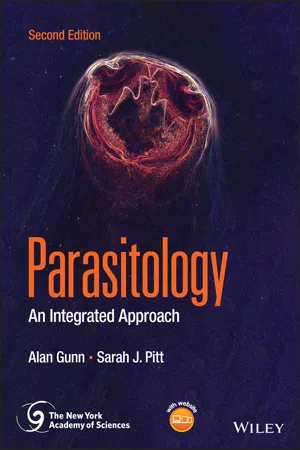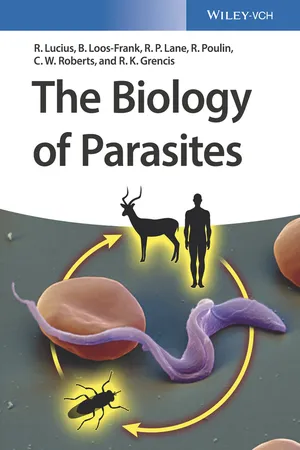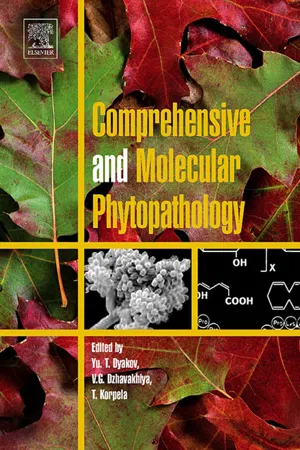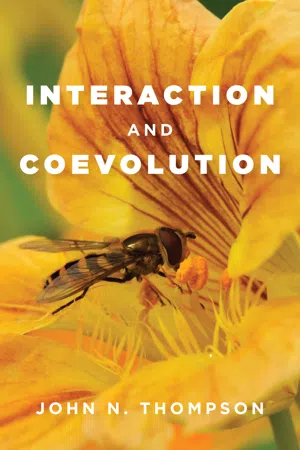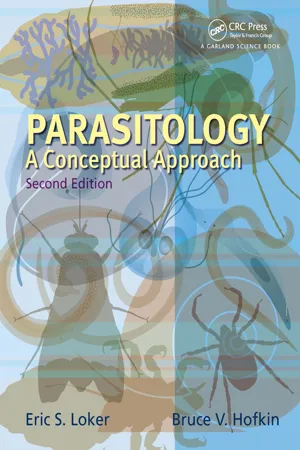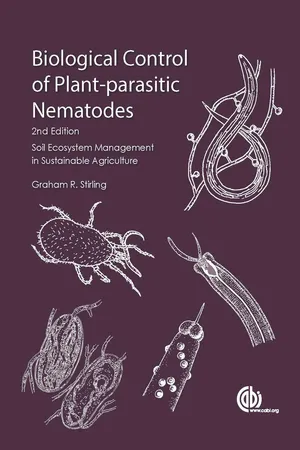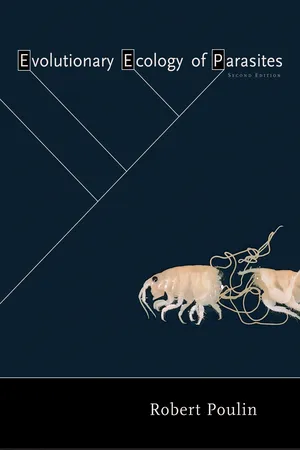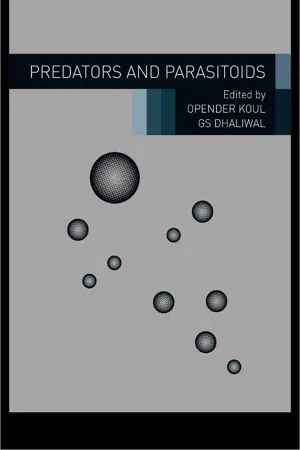Biological Sciences
Parasitism
Parasitism is a symbiotic relationship in which one organism, the parasite, benefits at the expense of another organism, the host. The parasite derives nutrients and resources from the host, often causing harm or disease in the process. This relationship can be detrimental to the host's fitness and survival, while providing an advantage to the parasite.
Written by Perlego with AI-assistance
Related key terms
Related key terms
1 of 4
Related key terms
1 of 3
11 Key excerpts on "Parasitism"
- eBook - ePub
Parasitology
An Integrated Approach
- Alan Gunn, Sarah J. Pitt(Authors)
- 2022(Publication Date)
- Wiley(Publisher)
1 Animal Associations and the Importance of ParasitesCONTENTS
- 1.1 Introduction
- 1.2 Animal Associations
- 1.2.1 Symbiosis
- 1.2.2 Commensalism
- 1.2.3 Phoresis
- 1.2.4 Mutualism
- 1.2.5 Parasitism
- 1.2.6 Parasitoids
- 1.2.7 The Concept of Harm
- 1.3 Parasite Hosts
- 1.4 Zoonotic Infections
- 1.5 The Co‐evolution of Parasites and Their Hosts
- 1.5.1 The Red Queen’s Race Hypothesis
- 1.5.2 Parasites in the Fossil Record
- 1.5.3 Parasites and the Evolution of Sexual Reproduction
- 1.6 Parasitism as a ‘Lifestyle’: Advantages and Limitations
- 1.7 The Economic Cost of Parasitic Diseases
- 1.7.1 DALYs: Disability‐Adjusted Life Years
- 1.8 Why Parasitic Diseases Remain a Problem
1.1 Introduction
In this chapter, we introduce the concept of Parasitism as a lifestyle and explain why it is such a difficult term to define. We also introduce some of the terms commonly used by parasitologists. Like all branches of science, parasitology uses specialist terms such as ‘intermediate host’, ‘definitive host’ and ‘zoonosis’ that one must understood before one can make sense of the literature. We explain why the study of parasites is so important and why parasitic infections will remain a problem in human and veterinary medicine for many years yet to come.1.2 Animal Associations
All animals are in constant interaction with other organisms. These interactions can be divided into two basic types: intra‐specific interactions and inter‐specific interactions.Intra‐specific interactions are those that occur between organisms of the same species. They range between relatively loose associations such as those between members of a flock of sheep and highly complex interactions such as those seen in colonial invertebrates. For example, the adult (medusa) stage of the Portuguese man o’ war ‘jellyfish’ (Physalia physalis) may appear to be a single organism but is actually composed of colonies of genetically identical but polymorphic individuals. These colonies divide labour between themselves in a similar manner to that of organ systems within a non‐colonial organism. For example, some colonies are specialised for reproduction, whilst others are specialised for feeding. The term ‘jellyfish’ is in inverted commas because although P. physalis - eBook - ePub
- Richard Lucius, Brigitte Loos-Frank, Richard P. Lane, Robert Poulin, Craig Roberts, Richard K. Grencis, Ron Shankland, Renate FitzRoy(Authors)
- 2017(Publication Date)
- Wiley-VCH(Publisher)
Interactions between individuals of the same species are thus excluded, even if the benefits of such interactions are very often unequally distributed in the colonies of social insects and naked mole rats, for instance, or in human societies. As a result, the interaction between parents and their offspring does not fall under this category, although the direct or indirect manner in which the offspring feed from their parent organism can at times be reminiscent of Parasitism. The principle of one side (the parasite) taking advantage of the other (the host) applies to viruses, all pathogenic microorganisms, and multicellular parasites alike. This is why we often find that no clear distinction is made between prokaryotic and eukaryotic parasites. With regard to parasites, we usually do not differentiate between viruses, bacteria, and fungi on the one hand and animal parasites on the other; we tend to see only the common parasitic lifestyle. Even molecules to which a function in the organism cannot be assigned are sometimes described as parasitic, such as prions, for example, the causative agent of spongiform encephalopathy, or apparently functionless “selfish” DNA plasmids that are present in the genome of many plants. Many biologists are of the opinion that only parasitic protozoa, parasitic worms (helminths), and parasitic arthropods are parasites in the strict sense of the term. Parasitology, as a field, is concerned only with those groups, while viruses, bacteria, fungi, and parasitic plants are dealt with by other disciplines. This restriction clearly hampers cooperation with other disciplines, something that seems antiquated in today's modern biology, where all of life's processes are traced back to DNA; it is gratifying that the boundaries have relaxed in recent years. However, eukaryotic parasites are distinguished from viruses and bacteria by their comparatively higher complexity, which implies slower reproduction and less genetic flexibility - eBook - ePub
- Yuri Dyakov, Vitaly Dzhavakhiya, Timo Korpela(Authors)
- 2007(Publication Date)
- Elsevier Science(Publisher)
All these aspects are integrated in the focus on studying interaction between a higher and lower organism, host plant and parasite. Without knowledge, analysis, and practical use of this interaction, even the most resistant cultivars will rapidly lose resistance, and the most active fungicides will become inefficient.Passage contains an image
Chapter 0Overview on Parasitism
Yu. T DyakovPublisher Summary
The chapter describes Parasitism. Parasitism is the ability of an organism to develop in/on another organism while consuming the host’s nutrients for its own growth and reproduction. Plants can host various species of parasites: fungal, bacterial, viral, and so on. They can be isolated and identified. In a living plant, we observe obligate parasites, facultative saprotrophs, and much less frequently, facultative parasites. In a dead plant, we can find obligate saprotrophs, facultative parasites, and less frequently, facultative saprotrophs. To explain these facts, the chapter discusses the essential features of parasites. According to the type of feeding, microorganisms are classified into saprotrophs, necrotrophs, and biotrophs. Saprotrophs extract nutrients from dead tissues, that is, they are saprophytes, while necrotrophs and biotrophs are parasites. Necrotrophs kill a plant or its part with toxic secretion before occupying it, which actually means that they feed on dead cells, similar to saprophytes. Biotrophs extract nutrients directly from living cells. This type of nutrition causes considerable changes in a parasite’s metabolism and morphogenesis. Therefore, trophicity is an important taxonomic property for dividing some bacterial and fungal species. Pathogenicity is the main feature of pathogenic organisms. Pathogenicity is viewed as a complex trait distinguishing parasites from nonparasites or the ability to cause damage in the infected plant.Types of host–parasite relationship
Organisms in ecosystems can interact with each other in different ways as shown in Table 0.1 . Apparently, two organisms in direct contact, or in chemical contact through extracellular metabolites cannot avoid the interaction. Zeroes in Table 0.1 - eBook - ePub
- John N. Thompson(Author)
- 2014(Publication Date)
- University of Chicago Press(Publisher)
A parasite is an organism that lives throughout a major period of its life in or on a single host individual, deriving its food from the host and causing lowered survival or reproduction in the host. Although the term parasite is used most often with reference to small animals or microorganisms that live in or on larger animals—as suggested by the usual content of parasitology journals and texts—this way of obtaining food is common among many taxa. Parasites include, for example, parasitic fungi of plants, herbivores such as caterpillars and aphids that spend all of their larval or nymphal stages on a single host plant, insect parasitoids of other insects that live as larval parasites in their hosts but have a free living adult stage, as well as the parasites usually considered in parasitology such as the cestode parasites of animals. Including the interactions between some phytophagous insects and plants in the application of the term parasite does not broaden the use of the term beyond utility, as has been suggested by some authors (Holling, 1980; Brooks, 1981). Instead, it does just the opposite by using the term in an ecological and evolutionary sense rather than in a sense set arbitrarily by taxonomic boundaries. The purpose of the broad application of the term parasite is to search for general principles that transcend taxonomy in the interactions between organisms (Price, 1975b; 1977; 1980).The lack of an absolute discrete boundary between Parasitism and other kinds of interactions between victims and their enemies is at once both exciting to the evolutionary ecologist interested in the evolution of interactions between species and the transition states between, for example, Parasitism and predation, and also frustrating for those interested in categorizing in stone how species interact. Wheeler (1911) notes that “Parasitism is an extremely protean phenomenon, one which escapes through the meshes of any net of scholastic definitions in which we may endeavor to confine it.” Using a definition essentially the same as the one given above, however, Price (1977) estimates that over 50% of extant species are parasitic. - eBook - ePub
- Allen Grimshaw, Allen Grimshaw(Authors)
- 2017(Publication Date)
- Routledge(Publisher)
Parasitism originated in dim primordial antiquity as a consequence of habitual contacts between different living things. It did not develop suddenly, but evolved gradually, as one form adapted itself, step by step, to the environmental conditions found in or upon another. Parasitism, in its origin, means a breaking down of that opposition which, normally, every living cell complex offers to invasion by another living entity. The simplest illustration of this (for want of a better name, we may call it "vital resistance") is the well-known one of the frogs' eggs. They develop and remain free from invasion in a pond which is swarming with bacteria and Protozoa. A frost kills them overnight, and within a few hours their substances have become culture media for innumerable microörganisms. It is conceivable — and, indeed, could be supported by experimental evidence — that a diminution of this "vital resistance" — which is, in itself, a complex phenomenon — may let down the bars sufficiently to permit invaders to gain a preliminary foothold, even though the host does not succumb to the injury which rendered him susceptible. And once begun, the further evolution of Parasitism can proceed in an almost unlimited variety of directions.Parasitism represents that phase of evolutionary change which lends itself most easily to analysis. There are few parasites which cannot be traced with considerable clearness to some free-living ancestral stock, either still existent or available in fossil form. From this point of view, the study of parasitic adaptation is one of the most important buttresses of evolutionary theory. Each instance represents a miniature system in which the host is the world by which the parasite is moulded. The Parasitism which is infectious disease involves the invasion of more or less complex plants or animals by simpler, in most cases, unicellular, beings — like the bacteria, the Protozoa, the Rickettsiæ, and the curious, still undefinable agents of which we speak as "ultramicroscopic" or "filterable" viruses. Though actually complex in function and metabolism, these supposedly simple things display an amazing biologic and chemical flexibility; and since, in them, generations succeed each other with great speed (at least two every hour, under suitable circumstances), the phenomena of infection constitute an accelerated evolution extraordinarily favorable for the observation of adaptive changes. It would be surprising, therefore, if new forms of Parasitism — that is, infection — did not constantly arise, and if, among existing forms, modifications in the mutual adjustment of parasites and hosts had not taken place within the centuries of which we have record. - eBook - ePub
Parasitology
A Conceptual Approach
- Eric S. Loker, Bruce V. Hofkin(Authors)
- 2022(Publication Date)
- CRC Press(Publisher)
Figure 7.29 ).Figure 7.29 The road to Parasitism—at least two different paths. In the top pathway, a free-living progenitor establishes a symbiotic association with a host and develops a particular innovation or characteristic associated with Parasitism. In the bottom pathway, the free-living organism may have a particular precondition, or exaptation, that facilitates the transitions to Parasitism. (From Janouskovec J & Keeling PJ (2016) Curr Biol. 26:R157–R179. With permission from Elsevier.)We can imagine Parasitism originating in a few different ways. One common notion is that conditions experienced during free-living existence select for traits that may eventually serve the organism well if it adopted Parasitism. The process whereby a trait evolves for one purpose but later is used for another is called exaptation (see the bottom pathway in Figure 7.29 ). Note that the concept of exaptation does not imply that an organism is somehow foreseeing its future but rather that the current circumstances of its existence select for attributes that would also happen to be valuable if it adopted another very different type of lifestyle (such as Parasitism). For instance, the closest known free-living relative of kinetoplastid parasites (including the prominent genera Trypanosoma and Leishmania ) is the flagellated unicellular aquatic organism Bodo saltans that lives by ingesting other organisms. Many of the peculiar attributes of kinetoplastids are also found in Bodo including production of polycistronic messenger RNAs and loss of some metabolic pathways suggesting these attributes are not necessarily unique features of Parasitism per se. Also present in Bodo though are membrane surface proteins called bodonins believed to be involved in adhesion to surfaces and to prey items that are homologous to some of the distinctive surface molecules found in the parasitic kinetoplastids. Bodonins may be viewed as exaptations for Parasitism, later diversifying into molecules essential for the establishment of parasitic kinetoplastids in their insect vectors or for binding host molecules. Bodo however lacks the machinery associated with predictable antigenic variation in Trypanosoma , suggesting this is an example of an innovation associated with the adoption of Parasitism (example of the top pathway shown in Figure 7.29 - eBook - ePub
Parasitism and Parasitic Control in Animals
Strategies for the Developing World
- Hafiz Muhammad Rizwan, Muhammad Sohail Sajid, Hafiz Muhammad Rizwan, Muhammad Sohail Sajid(Authors)
- 2023(Publication Date)
- CAB International(Publisher)
1 Biology and Ecology of ParasitesHAFIZ MUHAMMAD RIZWAN1 *, SAIMA NAZ2, MOHSIN RAZA3, ASIF IQBAL4, TAHIRA IFTAKHAR5, HAIDER ABBAS1 ANDTAYYABA AKHTAR61 Department of Pathobiology, KBCMA College of Veterinary and Animal Sciences, Lahore, Pakistan; 2 Department of Zoology, University of Sindh, Jamshoro, Pakistan; 3 Department of Basic Sciences, KBCMA College of Veterinary and Animal Sciences, Narowal, UVAS, Lahore, Pakistan; 4 Department of Pathobiology, Riphah College of Veterinary Sciences, Lahore, Riphah International University, Islamabad, Pakistan; 5 Department of Parasitology, University of Agriculture, Faisalabad, Pakistan; 6 University of Veterinary and Animal Sciences, Lahore (Narowal Campus), Pakistan* Corresponding author: [email protected]© CAB International 2023. Parasitism and Parasitic Control in Animals: Strategies for the Developing World (eds H.M. Rizwan and M.S. Sajid)DOI: 10.1079/9781800621893.0001 AbstractParasites range from tiny, microscopic creatures to macroscopic species with a diverse range of classifications. They have various well-developed characteristics that make them sustainable in different habitats with several types of hosts. Parasites develop several types of relationships with their host and Parasitism causes damage to the host. Protozoa have unique features and their own classification. Helminths are much more advanced than protozoa as they are multicellular. Arthropods are the most successful creatures on the planet and among them dipterans are more prevalent. Among arthropods, mosquitoes and ticks are the main external parasites that act as vectors of many pathogens. The physical and climatic features of an area help to propagate these parasitic species. Parasitic infection causes a decline in animals’ productivity and causes diseases in humans and animals. For better control of parasitic infections, we should understand the biology and ecology of parasites. - eBook - ePub
Plant Disease Management
Principles and Practices
- Hriday Chaube(Author)
- 2018(Publication Date)
- CRC Press(Publisher)
Chapter 4Host-Parasite InteractionI. Introduction
Plants are constantly exposed to millions of microorganisms and many of them possess the faculty to attack plants. However, in nature disease is more an exception than a rule. Most of the microbes surrounding the plant are saprophytic, incapable of attacking a healthy plant. Only a few are pathogenic, but each one of these can only attack specific plant species. Furthermore, all the individuals of a host species are not equally susceptible to a given pathogen isolate. How are most of the microbes in contact with the plant surface rendered harmless? How does a plant defend itself against non-pathogens (pathogens of other species) and a pathogen? In order to properly understand these phenomenon it is essential to first understand the nature and evolution of Parasitism in plant pathogens and philosophy of defense in plants.II. Evolution of Parasitism
Unlike their animal counterparts, plants cannot eliminate their parasites; they try to live with them by limiting the latter's deleterious effects. At the same time a successful parasite also can cause less strain to the plant. It is from these considerations that symbiosis is considered to be the most advanced form of Parasitism. In the hypothetical hierarchy (Figure 1 ) of Parasitism it is natural to consider the saprotrophs as the bottom members—they colonize only dead organic matter. The intense competition among the saprotrophs for the same source of organic matter forced some of them to develop parasitic abilities, for example Phytium sp. appears to have the tendencies of a true saprophyte, but it has developed the faculty to become a parasite even though restricted to only attacking the juvenile and succulent plant tissues. Pathogens such as Rhizoctonia sp. and Sclerotium sp. can be considered as more hardy because, in addition to attacking tender tissues, they can also exploit comparatively mature tissues. All these pathogens have a very wide host range. They are necrotrophs, they cause extensive damage to the host tissue by employing enzymes and secondary toxic metabolites as their major weapons. On moving up the hypothetical hierarchical ladder of Parasitism (Figure 1 - eBook - ePub
Biological Control of Plant-parasitic Nematodes
Soil Ecosystem Management in Sustainable Agriculture
- Graham Stirling(Author)
- 2014(Publication Date)
- CAB International(Publisher)
Predation is generally characterized by the consumption or assimilation of one organism (the prey) by another, often larger, organism (the predator). It requires intimate contact between the two organisms and usually involves an active search for the prey by the predator. Protozoans, nematodes and microarthropods all have the capacity to consume other soil organisms, some feeding indiscriminately on a wide range of organisms and others having quite specific food preferences. With respect to nematodes, predators of bacteria and fungi are considered ‘bacterivores’ and ‘fungivores’, as this clearly specifies their food source and trophic position. Predators of organisms further along the food chain are referred to as ‘top predators’.Parasitism occurs when an organism (the parasite) lives in or on another organism (the host) and obtains all or part of its nutritional resources from that host. Bacteria and viruses are known to parasitize some soil organisms (e.g. protozoans and nematodes), but fungi are probably the most important parasitic organisms in soil. Numerous fungal parasites of arthropods and nematodes are known, and mycoParasitism (Parasitism of one fungus by another) is also commonly observed.Competition involves situations where the volume of habitable space, or the amount an essential substrate or nutrient, is insufficient to satisfy the needs of organisms requiring that resource. The organism most adept at accessing the limiting factor, making it inaccessible to others, or eliminating those trying to obtain it, will prosper relative to its competitors. Competition is a universal phenomenon within the soil food web, but becomes particularly intense when organisms in the same ecological niche are attempting to access the same scarce resource.Regulation of Populations by Resource Supply and Predation
The mechanisms outlined depict the types of interactions that occur between organisms in the soil food web. However, outcomes from those interactions are not easy to predict. Environmental factors have marked effects on relationships between organisms, while the interactions between two organisms will be modified by the introduction of a third organism. Thus, the structure of the biological community and the population size of individual components is the result of environmental effects and multiple interactions that are almost impossible to fully comprehend. - eBook - ePub
Evolutionary Ecology of Parasites
Second Edition
- Robert Poulin(Author)
- 2011(Publication Date)
- Princeton University Press(Publisher)
2 Origins of Parasitism and Complex Life CyclesParasites have obviously evolved from free-living ancestors—there first had to be animals around for parasites to exploit. Parasitism has originated independently in several animal taxa, and has sometimes arisen more than once in a given taxon. The origins of parasites typically go back several million years, as indicated by the classical fossil evidence (Conway Morris 1981) supplemented lately by the discovery of well-preserved specimens fossilized in amber (e.g., Poinar 1999; Klompen and Grimaldi 2001). Since these early days parasites have diversified greatly (Poulin and Morand 2000a, 2004), and modern species now display a wide variety of life cycles and adaptations to their parasitic existence. This chapter presents scenarios for the early origins and evolution of parasites and the subsequent increases in the complexity of their life cycles. Other aspects of the life history of parasites, such as the evolution of body size and reproductive output, will be covered in chapter 4 .2.1 Transitions to Parasitism
Two organisms of widely different sizes may come into contact for some time without the small one exploiting or harming the large one, and without the large one eating the small one. This is probably common in nature. If these encounters are frequent in a given pair of species, an opportunity exists for a more permanent association to develop. However, opportunity is only one of the requirements for the establishment of an intimate interspecific association. The parasite-to-be must possess some pre-adaptations for survival, feeding, and reproduction on the host, and its reproductive success as a parasite must be greater than its success as a free-living animal. Without pre-adaptations the parasite cannot begin to exploit the host, and without fitness benefits, host exploitation will not be favored by natural selection.The need for pre-adaptation of parasite precursors is an old idea (Rothschild and Clay 1952). Specialization for a parasitic existence may be gradual, but the initial stages of host exploitation must be possible at the onset. Selection would not gradually shape feeding and attachment organs from one generation to the next if the parasite could not derive benefits from the host, that is, fitness gains must precede specialization. Thus the animals that can become parasites are the ones capable of remaining in or on the host for certain periods of time, during which they can feed on the host and achieve greater fitness than their conspecifics that do not exploit hosts. The mouthparts and other structures necessary to feed on dead animals, or to burrow into plant stems, or to suck the sap of plants, are all examples of pre-adaptation to Parasitism on animals. Some gastropod molluscs (Bouchet and Perrine 1996) and ostracod crustaceans (Stepien and Brusca 1985), not usually known to be parasitic, have been documented feeding at night on fish resting near the seafloor. Crabs are usually free living but larval and adult crabs can enter the gill cavity of fish caught in traps on the seafloor, and feed on their gill filaments (Williams and Bunkley-Williams 1994). Such opportunistic foragers using a feeding apparatus designed for a different purpose could eventually evolve into specialized parasites forming more permanent and intimate associations with their fish hosts. Cymothoid isopods, for instance, are obligate ectoparasites of fish evolved from ancestors that were only facultative fish parasites (Brusca 1981). The closest relatives of the Cymothoidae, for example, Aegidae and Corallanidae, are still free-living predators of invertebrates capable of an occasional blood meal on a fish (Bunkley-Williams and Williams 1998). - eBook - ePub
- Opender Koul, G. S. Dhaliwal(Authors)
- 2003(Publication Date)
- CRC Press(Publisher)
Biological control of insect pests rests on the premise that pest population densities are amenable to control either by introduction and subsequent establishment of imported parasitoids into a new habitat (the classical approach) or by sustained, strategic releases of laboratory-reared parasitoids into the host habitat in order to achieve high parasitoid-to-host ratios (the augmentative or inundative approach) (DeBach, 1965). Another approach worth evaluation is hyperParasitism: secondary parasitoids that develop at the expense of primary parasitoids, thereby representing a highly evolved fourth trophic level (Sullivan and Völkl, 1999). There is substantial evidence available that hyperparasitoid community organization follows the same pattern as primary parasitoid communities. Studies on this topic, though reviewed earlier (Sullivan, 1987), should combine field and laboratory studies and should include cues involved in habitat and host location and take account of the importance of interactions with adult primary parasitoids and with hyperparasitoid predators at the habitat level (Völkl, 1997). Such an analysis will help to better understand individual patterns of resource utilization that are one key factor of hyperparasitoid population dynamics and its role in pest control (Sullivan and Völkl, 1999). Regardless of the approach, however, the question whether to introduce and utilize only one species or multiple species of parasitoids in suppression of target pest insects always comes to mind. Considering the magnitude, rigors, and costs of foreign exploration, this subject has remained a highly contested issue among research biologists and policy makers.MultiParasitism has been researched extensively over several decades. This paper will highlight the findings and controversies that have contributed to our understanding of this biological phenomenon. In addition, we will examine the implication of multiParasitism within the context of single or multiparasitoid introduction in biological control of insect pests.Nature of parasitoid competition
An understanding of how different species of parasitoids behave and interact in a complex faunal community is contingent upon the formulation of field strategies for parasitoid release. A common interaction in a trophic pyramid is the competition that occurs between or among different parasitoids that exploit the same host resources (Price, 1984). Adult parasitoids may compete for same food supply in the natural habitat, e.g., plant pollens, nectars, or honeydew secreted by sedentary insects such as coccids. However, the competition known as multiParasitism (also referred to as heterospecific or interspecific Parasitism), becomes extremely critical when the immatures of different parasitoid species utilize the same host individual as the only medium for nourishment and development (Price, 1984). Nevertheless, competition for the same host individual is not limited only to different species of parasitoids. Scramble (or free-for-all) type of struggle for survival inside a host likewise ensues between or among developing parasitoid immatures of the same species. In this case, the host insect is said to be superparasitized (DeBach, 1965): a host may be oviposited with more than one egg by the same gravid female (self parasitization) or by different females of same species (conspecific parsitization). In retrospect, if parasitoid attack occurs in already parasitized host, it is said to be superparasitized or multiparasitized depending on whether the egg-laying female is of the same or different species. Either way, the immature(s) of the parasitoid that predominates over less-aggressive competitors will successfully complete development inside the host. Gregarious or polyembryonic species of parasitoids will produce several progeny from a cohort of eggs deposited inside individual host, while only one offspring will successfully develop from a host parasitized by strictly solitary endoparasitoids (DeBach, 1965).
Index pages curate the most relevant extracts from our library of academic textbooks. They’ve been created using an in-house natural language model (NLM), each adding context and meaning to key research topics.
Explore more topic indexes
Explore more topic indexes
1 of 6
Explore more topic indexes
1 of 4
